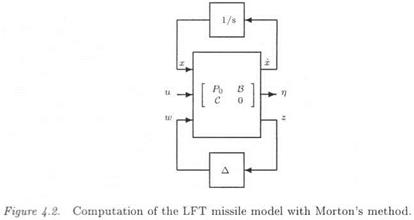MORTON’S METHOD
 |
This method is illustrated in the specific context of the missile example. The same result as in the previous subsection is obtained. The idea is to rewrite equations (2.11) of the linearized missile model as:
with:
![]() QS
QS
Mass * V QSd
h
![]() QS
QS
Mass * д
![]()
|
Ma = (1 + ^)М° Ms = (1 + S2)Ms Za = (1+*з)Я“ Zs = (1 + ВД0 |
|
|
|
|
|
|
|
|
|
|
|
|
|
|
|
|
|
|
|
|
 |
|
|
|
|
|
|
|
|
|

The above equations can thus be rewritten as:
= (Po + BAC) with Д = diag(6i, S2, S3, $4) and:
Let the augmented plant with additional fictitious inputs w and outputs z:

 |
(4.10)
When applying the fictitious feedback w = Az, the initial plant of equation (4.8) is recovered. The LFT model is given in Figure 4.2 (with x = [a, g]).











